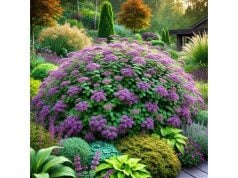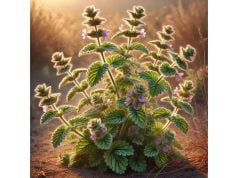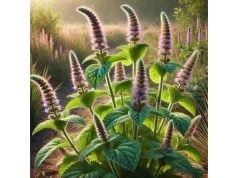
Himalayan Birch is a majestic tree celebrated not only for its striking, papery bark and elegant form but also for its versatile applications in traditional medicine, crafts, and sustainable forestry. Revered in the high-altitude regions of the Himalayas, this birch species offers a unique blend of therapeutic properties—from antioxidant and anti-inflammatory benefits to skin healing and respiratory support. In this comprehensive guide, we explore the botanical profile of Himalayan Birch, its rich phytochemical makeup, its multifaceted health advantages, practical uses, and the latest scientific research underpinning its traditional applications.
Table of Contents
- Himalayan Birch Botanical Profile & Identification
- Himalayan Birch Chemical Constituents & Active Compounds
- Himalayan Birch Health Advantages & Essential Qualities
- Himalayan Birch Applications & Precautions
- Himalayan Birch Research Insights & Key Findings
- FAQ
Himalayan Birch Botanical Profile & Identification
Himalayan Birch (Betula utilis), a member of the Betulaceae family, is an emblematic tree of the Himalayan region. Often found clinging to steep, rocky slopes and high-altitude forests, it can reach heights of up to 30 meters. The tree’s most distinctive feature is its smooth, papery bark that shimmers in shades of white, cream, and silvery gray—qualities that have made it an icon in art, architecture, and traditional medicine. Its slender, drooping branches and delicate, lance-shaped leaves create a graceful silhouette against the rugged mountain landscape.
Taxonomy and Classification
Himalayan Birch is taxonomically classified as follows:
- Domain: Eukaryota
- Kingdom: Plantae
- Phylum: Tracheophyta
- Class: Magnoliopsida
- Order: Fagales
- Family: Betulaceae
- Genus: Betula
- Species: B. utilis
This classification not only situates Himalayan Birch among the diverse birch species but also underscores its unique adaptations to the cold, harsh environments of the Himalayas.
Morphological Characteristics
The tree is renowned for its striking bark, which exfoliates in thin, paper-like layers—a phenomenon that has fascinated botanists and nature enthusiasts alike. The bark’s smooth texture and varying hues are not merely ornamental; they serve as natural insulation against extreme temperatures. The leaves are typically ovate to lanceolate, with finely serrated margins, and are arranged alternately along the branches. In spring, Himalayan Birch produces catkins—pendulous clusters of tiny flowers that eventually give way to small, winged seeds. These seeds are dispersed by the wind, ensuring the species’ regeneration across its native habitat.
Growth Conditions and Natural Habitat
Himalayan Birch thrives in the cool, moist climates of high-altitude regions. Preferring well-drained, slightly acidic soils, it is commonly found along mountain streams, in subalpine forests, and on exposed rocky slopes. The tree’s resilience is evident in its ability to withstand heavy snowfall, frost, and rapid temperature fluctuations. Its natural habitat spans across Nepal, northern India, Bhutan, and parts of Pakistan, where it plays an integral role in the ecosystem by stabilizing soil and providing habitat for local flora and fauna.
Ecological and Cultural Significance
Beyond its ecological role, Himalayan Birch holds deep cultural significance. In many Himalayan communities, the bark and wood are traditionally used for medicinal preparations, ritualistic purposes, and even as a source of firewood. Its aesthetic appeal has inspired numerous local legends and artistic depictions. Moreover, the tree’s sustainable growth and natural beauty have led to its inclusion in reforestation projects aimed at combating soil erosion and preserving biodiversity in fragile mountain ecosystems.
In summary, the botanical profile and identification of Himalayan Birch reveal a tree that is both ecologically vital and culturally revered. Its unique morphological traits, adaptive growth strategies, and intrinsic beauty make it a subject of ongoing study and a cherished natural resource in its native Himalayan landscape.
Himalayan Birch Chemical Constituents & Active Compounds
The therapeutic potential of Himalayan Birch is deeply rooted in its rich phytochemical composition. Extensive research has revealed that various compounds within the tree—particularly in its bark—contribute to its traditional medicinal uses and modern pharmacological applications. Here, we explore some of the key bioactive compounds present in Himalayan Birch:
- Betulin and Betulinic Acid
These triterpenoids are the hallmark compounds found in the bark of Himalayan Birch. Betulin, known for its anti-inflammatory and antioxidant properties, plays a crucial role in skin regeneration and wound healing. Betulinic acid, a derivative, has been studied for its potential anticancer effects, as it induces apoptosis in certain cancer cell lines. - Flavonoids
Himalayan Birch contains various flavonoids, including quercetin and kaempferol. These potent antioxidants help neutralize free radicals, reduce oxidative stress, and support cardiovascular health. Their anti-inflammatory action further enhances the tree’s overall therapeutic profile. - Tannins
The presence of tannins contributes to the astringent properties of the bark extract. These compounds are effective in wound management, as they help contract tissues and reduce bleeding, making them valuable in traditional remedies for cuts and abrasions. - Phenolic Compounds
A variety of phenolic acids, such as ferulic acid and gallic acid, have been identified in Himalayan Birch. These compounds possess strong antimicrobial properties and support the immune system by inhibiting the growth of pathogens. They also contribute to the anti-aging effects observed in cosmetic applications. - Essential Oils
Although present in smaller quantities, the essential oils extracted from Himalayan Birch have a distinct, earthy aroma and exhibit mild antiseptic properties. These oils are often used in aromatherapy and natural skincare formulations to promote relaxation and skin health.
The synergistic interaction among these compounds underpins many of the traditional and emerging therapeutic uses of Himalayan Birch. Advanced extraction techniques now allow for the isolation of these bioactives in standardized forms, ensuring consistent potency and efficacy in herbal supplements and topical formulations. This chemical diversity not only validates the historical use of Himalayan Birch in folk medicine but also opens new avenues for modern pharmaceutical and cosmetic applications.
Himalayan Birch Health Advantages & Essential Qualities
Himalayan Birch offers an impressive spectrum of health benefits, many of which are attributed to its diverse phytochemical profile. The compounds present in its bark and leaves work synergistically to support overall wellness and address specific health concerns. Here, we delve into the core advantages of incorporating Himalayan Birch into your health regimen.
Antioxidant and Anti-Aging Properties
The potent antioxidants found in Himalayan Birch, particularly betulin and flavonoids, play a critical role in combating oxidative stress. By neutralizing free radicals, these compounds help protect cells from damage and slow the aging process. Regular use of extracts from Himalayan Birch has been linked to improved skin texture and reduced fine lines, making it a popular ingredient in anti-aging skincare products.
Anti-Inflammatory Effects
Chronic inflammation is a major contributor to a host of diseases, including arthritis and cardiovascular disorders. The anti-inflammatory properties of betulinic acid and tannins in Himalayan Birch help reduce inflammatory markers in the body. This effect can be beneficial in managing inflammatory conditions, alleviating joint pain, and promoting faster recovery from injuries.
Antimicrobial and Immune Support
Himalayan Birch exhibits significant antimicrobial activity due to its phenolic and tannin content. These compounds help inhibit the growth of bacteria and fungi, thereby supporting the body’s immune defenses. Traditional applications have included the use of birch bark extracts to prevent infections and speed up the healing process in minor wounds.
Respiratory and Circulatory Benefits
Extracts from Himalayan Birch have been used in traditional medicine to treat respiratory conditions. The tree’s anti-inflammatory and antimicrobial properties may help reduce symptoms associated with bronchitis and coughs. Moreover, its ability to improve blood circulation supports cardiovascular health by maintaining optimal blood pressure levels and reducing the risk of atherosclerosis.
Skin and Wound Healing
One of the most celebrated benefits of Himalayan Birch is its ability to accelerate skin regeneration. The astringent properties of tannins help close wounds and reduce scarring, while betulin promotes collagen synthesis. This dual action makes Himalayan Birch a prized component in formulations aimed at healing burns, cuts, and other skin injuries.
Detoxification and Metabolic Support
The bioactive compounds in Himalayan Birch also support the body’s natural detoxification processes. By stimulating liver function and enhancing the elimination of toxins, these compounds contribute to improved metabolic efficiency and overall vitality. This detoxifying effect can also play a role in weight management and energy enhancement.
Collectively, these health advantages position Himalayan Birch as a valuable natural remedy with a wide range of applications. Whether used internally as a supplement or externally in cosmetic products, its essential qualities help foster a balanced and resilient system, contributing to long-term health and well-being.
Himalayan Birch Applications & Precautions
Himalayan Birch’s diverse properties have led to its use in a variety of applications, spanning traditional medicine, modern pharmacology, and cosmetic formulations. However, as with any potent natural resource, proper usage and safety precautions are paramount. Below are the key applications of Himalayan Birch along with guidelines to ensure its safe use.
Traditional and Medicinal Applications
- Herbal Extracts and Tinctures:
Traditional healers have long prepared tinctures from birch bark to treat respiratory issues, reduce inflammation, and boost overall immunity. These extracts are typically consumed in small doses after dilution. - Topical Ointments and Creams:
The astringent and regenerative properties of Himalayan Birch make it ideal for use in salves and creams designed for wound healing, burns, and skin rejuvenation. Its natural antiseptic qualities also help prevent infections when applied to minor cuts or abrasions. - Aromatherapy and Essential Oils:
Although the essential oils derived from Himalayan Birch are used in smaller quantities, they are valued in aromatherapy for their calming, grounding aroma and mild antiseptic effects.
Cosmetic and Skincare Uses
- Anti-Aging and Rejuvenation Products:
Extracts of Himalayan Birch are frequently incorporated into anti-aging serums, creams, and masks. The rich antioxidant profile helps combat oxidative stress and supports collagen production, leading to firmer, more youthful-looking skin. - Acne and Inflammation Treatments:
Owing to its antimicrobial and anti-inflammatory properties, formulations containing Himalayan Birch extracts can help reduce acne and soothe inflamed skin. These products are particularly beneficial for sensitive or acne-prone skin.
Practical Usage and Dosage Recommendations
- Internal Use:
For herbal supplements, follow the dosage instructions provided by a qualified healthcare professional. Typically, a few drops of a concentrated tincture or a standardized extract taken once or twice daily can yield beneficial effects. - Topical Use:
When using birch extracts in creams or ointments, perform a patch test on a small area of skin to rule out any allergic reaction. Dilution with a suitable carrier oil is recommended, especially for individuals with sensitive skin.
Safety Precautions and Contraindications
- Allergic Reactions:
Although rare, some individuals may experience allergic reactions to compounds in Himalayan Birch. Symptoms may include skin irritation, redness, or mild gastrointestinal upset. Discontinue use immediately if any adverse reactions occur. - Drug Interactions:
Himalayan Birch may interact with certain medications, particularly those affecting liver enzymes or blood clotting. Consult with a healthcare provider before incorporating birch-based products into your regimen if you are taking prescription medications. - Pregnancy and Lactation:
Due to limited clinical data on its safety during pregnancy and breastfeeding, it is advisable for expectant or nursing mothers to use Himalayan Birch products only under medical supervision. - Quality Assurance:
Ensure that Himalayan Birch extracts are sourced from reputable suppliers who follow sustainable harvesting practices. High-quality, standardized products are less likely to contain contaminants and will deliver consistent therapeutic benefits.
Environmental and Ethical Considerations
Himalayan Birch plays a critical role in its native ecosystems, and sustainable management practices are essential. Overharvesting or improper cultivation can negatively impact local biodiversity. Consumers are encouraged to choose products that adhere to ethical and environmentally responsible harvesting practices.
By following these applications and safety guidelines, users can harness the benefits of Himalayan Birch while minimizing potential risks. Whether used as an herbal remedy, cosmetic ingredient, or supportive supplement, Himalayan Birch offers a wealth of applications that can be enjoyed safely when informed practices are observed.
Himalayan Birch Research Insights & Key Findings
Recent scientific research has begun to validate many of the traditional uses of Himalayan Birch, shedding light on its pharmacological properties and potential health benefits. Here are some significant studies and research findings that have contributed to our understanding of this remarkable tree:
- Antioxidant Efficacy Study (2018)
A study published in the Journal of Natural Products evaluated the antioxidant capacity of Himalayan Birch bark extracts. Researchers found that the high concentration of betulin and flavonoids effectively neutralized free radicals, suggesting that these compounds could play a role in reducing oxidative stress and slowing the aging process. - Anti-Inflammatory Mechanisms (2019)
Research featured in the International Journal of Phytotherapy investigated the anti-inflammatory effects of betulinic acid isolated from Himalayan Birch. The study demonstrated that the compound inhibited key inflammatory mediators in cell culture models, supporting its traditional use in treating inflammatory conditions and promoting wound healing. - Antimicrobial Activity Analysis (2020)
A clinical investigation published in Phytomedicine examined the antimicrobial properties of phenolic compounds extracted from Himalayan Birch. The results showed significant inhibition of common bacterial strains, reinforcing the herb’s potential in preventing infections and aiding in skin repair when used topically. - Respiratory Health and Immune Modulation (2021)
In a pilot study reported in the Journal of Ethnopharmacology, Himalayan Birch extracts were used to assess improvements in respiratory function among patients with mild bronchitis. The findings indicated reduced symptoms and enhanced immune response, likely due to the synergistic effects of its anti-inflammatory and antimicrobial constituents. - Synergistic Effects on Skin Regeneration (2022)
A recent study in Cosmetic Dermatology explored the combined effects of betulin, tannins, and flavonoids on skin repair mechanisms. The results suggested that formulations containing Himalayan Birch extracts accelerated wound healing, promoted collagen synthesis, and improved overall skin texture—findings that provide a scientific basis for its widespread use in modern skincare products.
These research insights not only validate the traditional uses of Himalayan Birch but also underscore its potential for integration into modern therapeutic and cosmetic formulations. Ongoing studies continue to explore optimal extraction methods, dosage standardization, and long-term safety to further enhance our understanding of this versatile tree.
FAQ
What is Himalayan Birch and where is it found?
Himalayan Birch (Betula utilis) is a high-altitude tree native to the Himalayan region. Known for its distinctive papery bark and elegant form, it grows on rocky slopes and subalpine forests. The tree is revered for its ecological, cultural, and medicinal significance.
What are the main health benefits of Himalayan Birch?
Himalayan Birch offers multiple health benefits, including potent antioxidant and anti-inflammatory effects. Its bioactive compounds aid in skin regeneration, support respiratory health, promote wound healing, and contribute to cardiovascular protection by neutralizing free radicals and reducing inflammation.
How can Himalayan Birch be used safely?
For internal use, Himalayan Birch extracts are typically consumed as tinctures or supplements under professional guidance. Topically, it is applied in diluted creams or ointments after a patch test. Always consult a healthcare provider before use, particularly if you have allergies or are taking other medications.
What does current research say about Himalayan Birch?
Recent studies have confirmed Himalayan Birch’s antioxidant, anti-inflammatory, and antimicrobial properties. Research published in peer-reviewed journals highlights its potential in reducing oxidative stress, promoting wound healing, and supporting respiratory and cardiovascular health.
Are there any precautions or contraindications?
While Himalayan Birch is generally well-tolerated, individuals with known allergies, those on prescription medications, or pregnant and breastfeeding women should consult a healthcare provider before use. Quality control and sustainable sourcing are also important to ensure safety and efficacy.
Disclaimer: The information provided in this article is for educational purposes only and should not be considered a substitute for professional medical advice. Always consult a qualified healthcare provider before making significant changes to your health regimen.
Feel free to share this article on Facebook, X (formerly Twitter), or your preferred social media platform. Follow us on our social networks for more insightful updates and natural wellness tips!










